With the year quickly drawing to a close it’s time for a quick wrap up the most important things that happened and WOW, what a year it’s been.
Thank you to everyone who has visited the blog and supported us in making Auckland greater.
Public Transport
City Rail Link
Despite the disruption from COVID, it’s been another big year for the CRL with the second tunnel being started and completed. The team have also finished the excavation of the stations and they’ve started the work to install tracks and other rail system in the tunnels. Recently I was lucky enough to get a visit to the Karanga-a-Hape station and wow, is it impressive. The COVID disruption along with global supply chain and now inflation issues are taking a toll on the project though, and we’re waiting to hear just how much more it will cost. That’s something to cover next year.
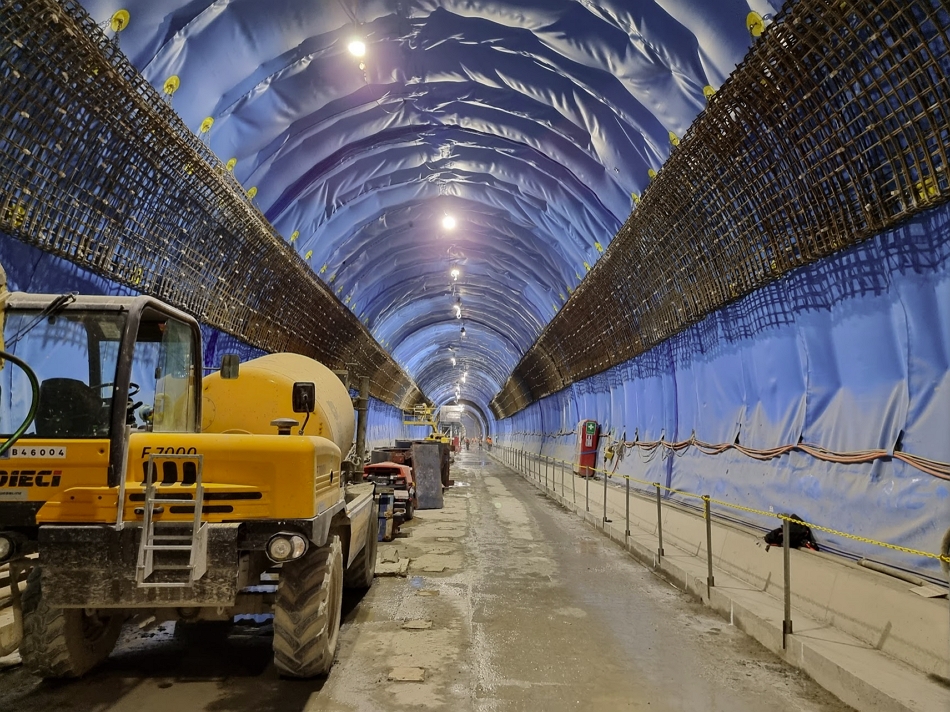
Rail Network Works
It’s been known for a while there is a heap of work to do to get the rail network ready for the CRL. in October, we learnt just how disruptive that was going to be, with Kiwirail announcing 2-3 years of rolling shutdowns to rebuild the foundations under the tracks. The first section to be worked on is the inner southern line, and a three-month shutdown starts next week. That will be followed by a nine-month shutdown of the inner eastern line, with the remainder of the network being done in 2024 and 2025.

Bus Driver Shortage
Disruption has also been a serious issue on the bus network this year: Auckland is short of over 500 drivers, resulting in thousands of bus services being cancelled every week. The issue is so bad that Auckland Transport has now removed many of the regularly cancelled buses from their timetables.
There has been some work to address bus driver shortages, with a series of announcements that will see average wages rise from $23.71 per hour to $30 per hour. However it appears that won’t be enough to fix the buses, as the Council looks to cut those services permanently in order to save some money.
Northern Busway Extension
One great piece of news this year was the completion in May of the Northern Busway extension to Albany, helping to make the NX buses faster and more reliable. However, it will be a few more years before we see the completion of the new Rosedale station.
Light Rail
We started the year with the government announcing they had picked tunnelled light rail as their preferred option. We think this is “the worst of both worlds” option, as it costs nearly $15 billion and doesn’t really provide that much additional benefit over a surface option.
As of the end of the year, we still seem no closer to this project even starting – when it would have been operating by now, had Labour not been distracted by the Superfund back in 2018.
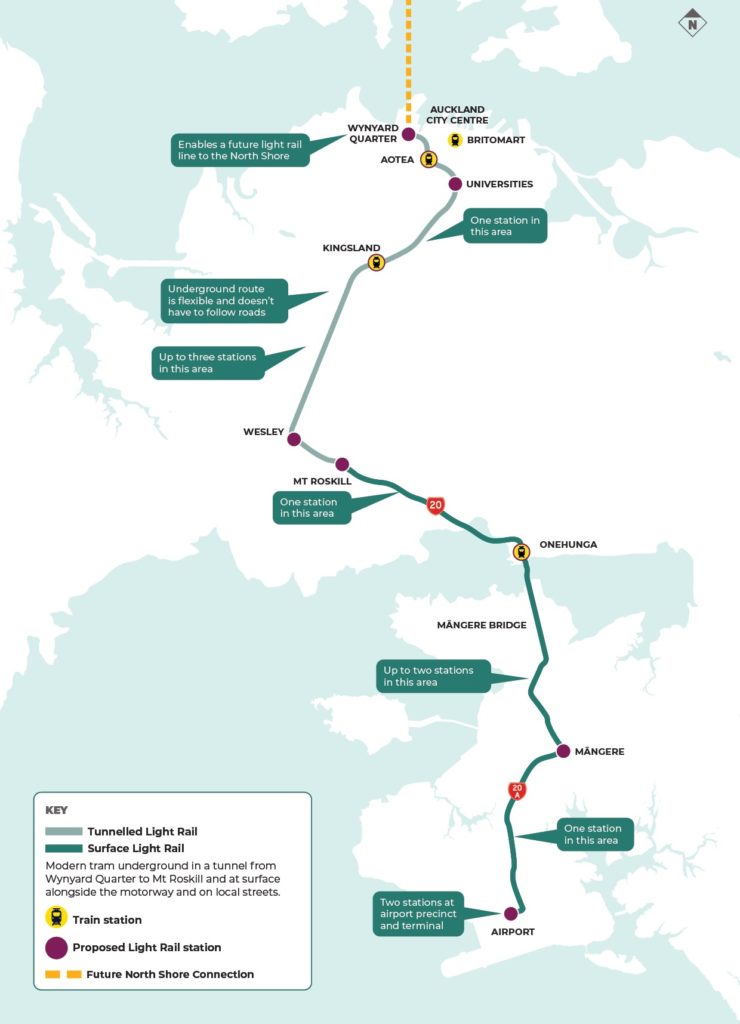
Ferry Changes
Finally we’ve seen some movement on the long-running exception that meant Devonport and Waiheke ferry services were operated independently of the rest of the public transport network. Devonport has been brought fully into the standard contracting model. Waiheke will still be run independently, but will be subject to new minimum service levels.
Perhaps more interesting is this year we’ve seen the announcement of significant investment in new ferries. The government has funded two fully electric ferries and Auckland Transport will take over the procurement for five new hybrid ferries.

Ridership
Usage of public transport has been severely impacted this year, initially by the effects of COVID restrictions and then by bus driver shortages. As a result, in recent months we’re still just tracking at about 65% of pre-COVID ridership.

Active Modes and Urban Realm
Glen Innes to Tamaki Dr Stage 2
This year saw the completion of two major shared path projects. The first was Section 2 of the Glen Innes to Tamaki Drive project, a 2.65km section of path that runs between St Johns Rd and Meadowbank Station, mostly alongside the rail corridor. A final section will connect to Tamaki Drive, and complete over 7km of path from Glen Innes to the waterfront.
New Lynn to Avondale
The second major opening was a 2.9km path between New Lynn and Avondale, also a railway-adjacent path and including a new rail underpass. Both paths are useful additions to the network though there are some quite different levels of quality, and ongoing concerns about the pinch points and road crossings on the New Lynn to Avondale path.
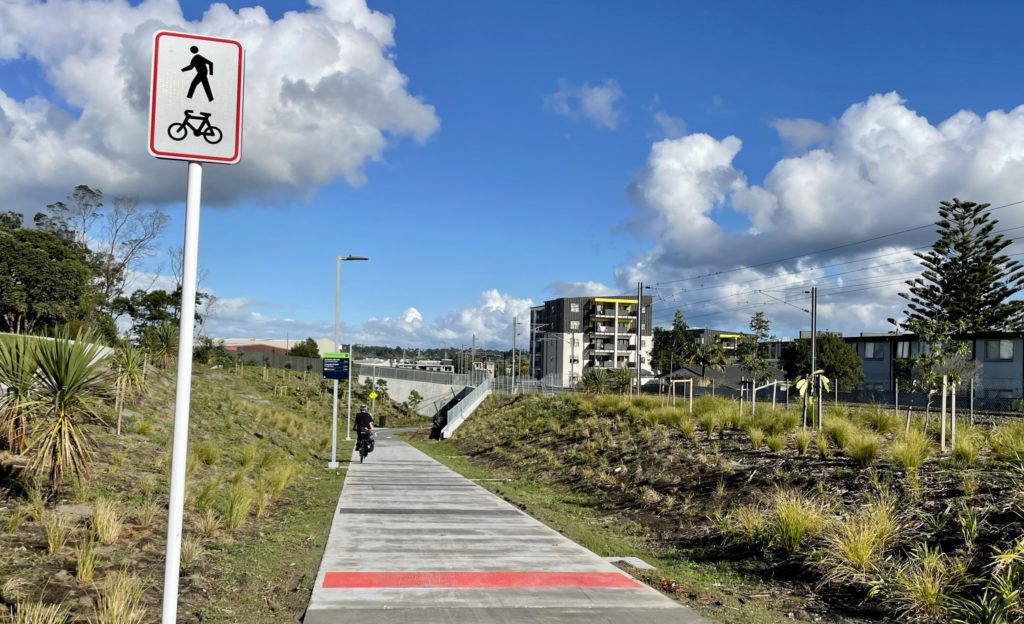
Queen St
This year saw the relatively rapid rollout of paving on Queen St, widening the footpaths to create more space for people. The results are certainly a big improvement on what we had before and it will be interesting to see if people gravitate to the new space.
I do feel our original criticism about not including a clearly defined cycleway still stands. Something has gone awry when you need videos, signage, artwork and now labels on the ground to help people understand how to use a path.
Another part of the changes involves making sections of Queen St only accessible for buses and other authorised vehicles. The implementation of this hasn’t been all that smooth though, and there are still far too many cars driving along Queen St.
Safety
It’s been a horror year on our roads. As of yesterday, 361 people have died on New Zealand’s roads. By comparison, as of the same time in the last two years just over 300 people had died; and around 340 had in 2019.
Perhaps more concerning is that within those numbers we can see a lot more deaths of people who were simply out walking or riding their bikes.
In Auckland, that included 19 year old Levi James who died near Royal Oak roundabout, in a location that cyclists told Auckland Transport was unsafe when a recent redesign was considered. AT ignored this information, and nine months later still have made no changes whatsoever to the road.
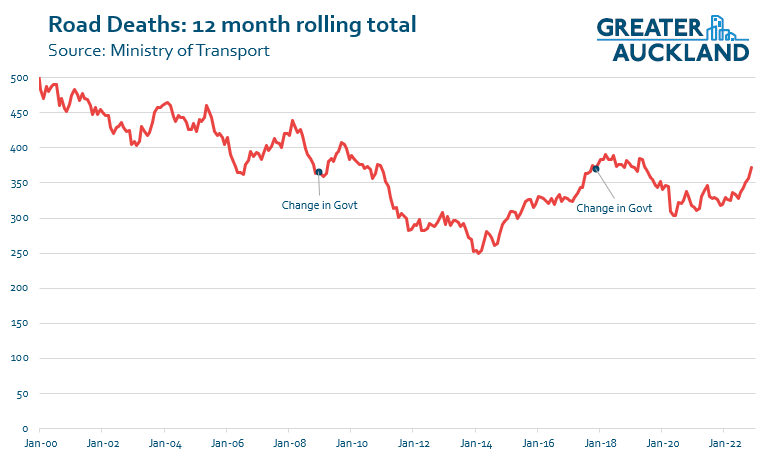
Upper Harbour Drive
One of the programmes from Auckland Transport we’ve been the most excited about was adding protection to around 60km of existing painted cycleways. This programme was announced last year, but the first treatments were rolled out this year. Most locations have been installed with no issues. But Upper Harbour Drive, one of the first to hit the ground, became the subject of community opposition after a number of drivers crashed into the barriers – thus proving the need for them.
As something of a conclusion to this, earlier this month AT announced they’d be changing the road laoyout to create a bi-directional cycleway on the eastern side. On the one hand, this shows the limits of a quick-protection programme when there’s local pushback, but it also shows how adaptable approaches can help reveal and solve issues at a particular location.

Roads
Penlink
Despite having supposedly a public-transport-friendly government and council (at the time), the biggest transport project to start in Auckland this year was the $830 million Penlink, a 7km road linking the Whangaparaoa Peninsula to SH1. It officially got under way earlier this month.

One thing we’re particularly concerned about with this project is that despite the cost, the active modes facilities are sub-Vision Zero standard, and far from safe. The project includes a shared path, and walkers and cyclists using the path will be forced to cross intersections at-grade.
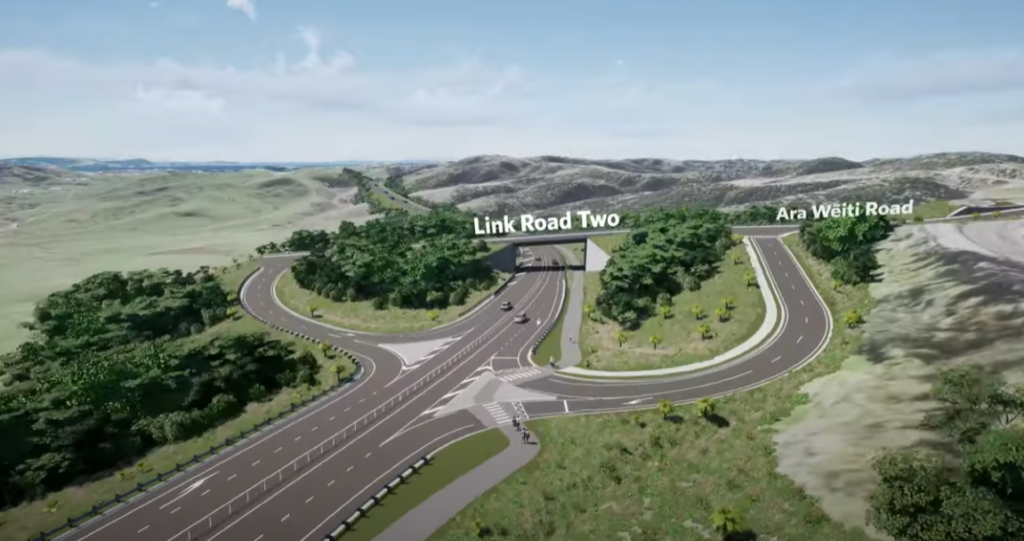
Puhoi to Warkworth
A bit further north, one of the last of the previous government’s Roads of National Significance is getting close to completion.
Northern Corridor
And, south of Penlink, the Northern Corridor Improvements project is also getting closer to completion. I still find it somewhat surprising that the busway has been finished before the motorway works.
Additional Waitemata Harbour Crossing
In addition to light rail, the government also announced they were bringing forward work on another harbour crossing. Other than a survey last month about whether we want public transport and cycling options, there has been little additional information about the project. That will likely change next year.
Other
Fuel Tax and PT Fare discounts
Inflation is running rampant across the world right now. In March, the government moved to cut fuel taxes by 25c per litre, and to halve public transport fares. Initially, this was meant to only be for three months but it has been extended a number of times – most recently last week, meaning it will be in force till the end of March 2023.
Some research by Waka Kotahi estimates this has resulted in about a 10% increase in PT ridership in Auckland, which isn’t bad considering the impacts of driver shortages and reduced timetables, not to mention changes in travel patterns with more people working from home.
New Mayor and Council
October brought the council elections. With Phil Goff standing down, we were always going to see a new Mayor. Wayne Brown won fairly easily in the end, and has already set about stamping his mark on the council and Auckland Transport.
Housing Changes
The council wwasere required this year to respond to the government’s mandated housing changes. In April, they released a draft consultation, finally giving us an idea of how they would choose to interpret factors such as walking distances to rapid transit stations, etc. In August, they then formally notified the changes.
For us. there were two main issues with the plan:
- Council planners spent all their time walking the streets (both physically and virtually) using a deeply flawed methodology to try and justify retaining as much special character zoning as possible – thereby limiting development in most of the high-amenity/high-demand areas close to the city.
- They left a massive void through the central isthmus due to uncertainties around light rail. Where this is most egregious is the walking catchments surrounding the existing train stations.
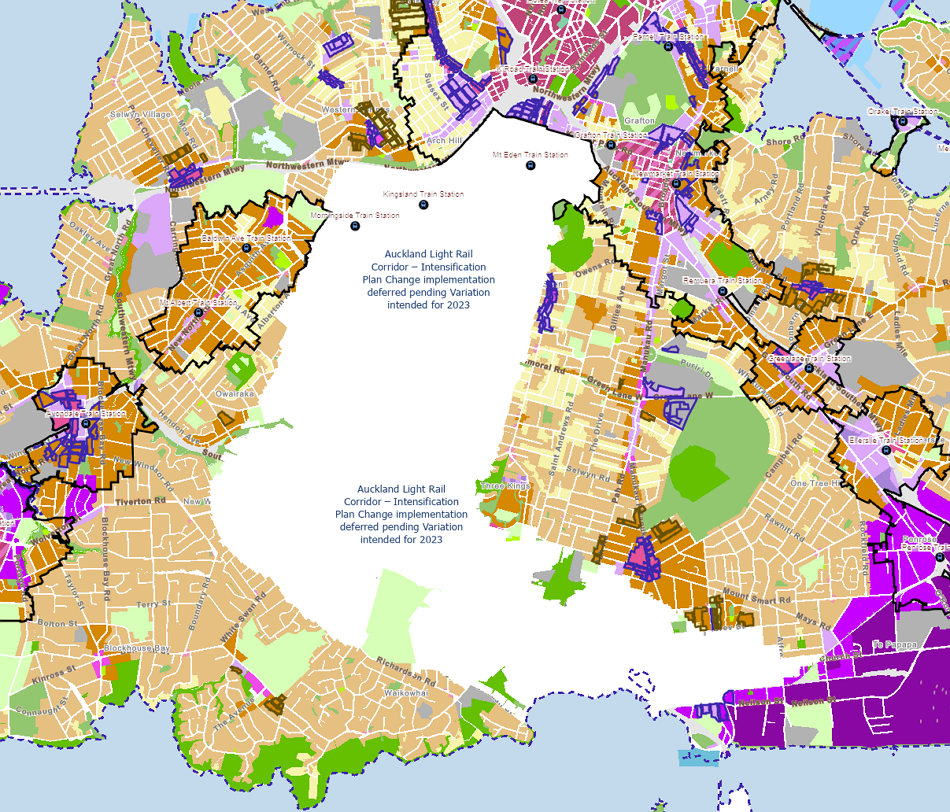
Blog News/Stats
It’s been another huge year for Greater Auckland, and I thought I’d share the top 10 most viewed posts:
- The Upper Harbour Options
- Concerning news coming out of Auckland Transport
- Unitary Plan 2.0 Pre-consultation
- 2022 Council Election Results
- Flashback Saturday: Why AWHC is the stupidest transport project ever
- Public transport in Auckland is beyond a joke right now
- Penlink To Start
- Sooo… Tunnelled Light Rail
- Switching sides: Sweden did it, should we?
- Flashback Saturday: Auckland Transport’s Parking Nonsense
We’ve had over 14,500 comments on posts this year – and thank you to all those who do genuinely engage with our work.
There’s so much more we could include here. What were your highlights of 2022?
This will be our last post for the year, so once again thanks for reading and supporting us. Have a happy and safe Christmas and New Year.
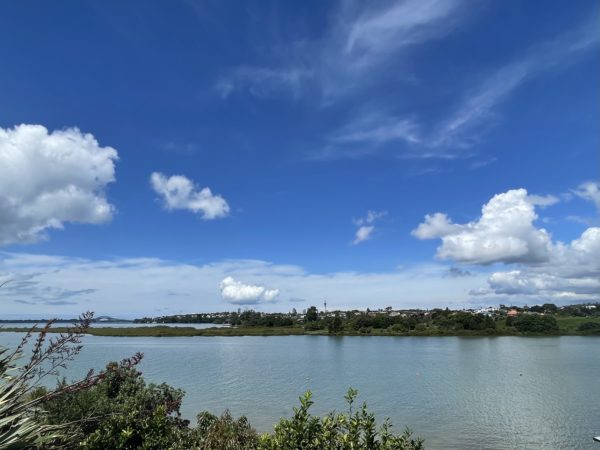

 Processing...
Processing...
Has anyone heard about connecting the cycle path in GI with the new one in Pakuranga that part of the busway? There was mention of it t being paid for a while ago with money not used for the harbour crossing. It just seems like with the up coming train cancellations it would be a no brainer to hurry up and get this done. I can’t find any information on it now.
I don’t think there was ever money set aside for the active-mode harbour crossing. It was just a concept with a cost estimate that was quickly rescinded.
Two observations on the CBD; a – too many private vehicles parking in the Queen Street loading zones and Fort Street shared zone and b – the rat running from Shortland to Commerce via Jean Batten and Fort shared zones. It can get to be nose to tail through there at peak and predominantly SOVs. No enforcement from AT.
Queen st, the need footpath area needs a reason for people to use. It is empty most of the time.
Some area are wide enough for a food/drink truck, chairs and tables, children play.
Amazing to see how much progress CRL has made. Awesome professional video.
http://www.stuff.co.nz/business/industries/130840849/bitumen-bandaids-not-enough-to-stop-decline-in-nz-roads?
Basic premise of this is ,roading network in a state of managed decline,with current maintenance practices unable to keep up with the wear and tear. Some of this is sheeted home to heavier trucks on the network,meaning the base is incapable of withstanding the constant heavier impacts,much like the rail network in Auckland.
Of course ,all of this can be remedied,but ,there’s a cost,clearly the roading network is underfunded,why else is it falling apart. Adding new roads into the mix,further spreads the funding thinner.
When can NZ,have a serious debate about,what we want from our roading network, and how much are we prepared to pay for it. Any discussion at the moment,gets hijacked by political interference,with parties seeing votes in adding roads.
To me,it has parallels to the US gun controls,most rational thinking leaders,know what has to be done,but just can’t bring themselves or their parties to do it. The inactions/misguided actions on both ,allow people to needlessly suffer. My wish for the new year,is for leaders to act like leaders,big ask in an election year,when considered thinking is overtaken by pork barreling.
There’s signs of this happening, with WK recently consulting on the land transport funding system with deliberative-democracy style “complex conversations”
https://www.complexconversations.nz/transport-perspectives/#perspectives
Further in-person workshops are set for next year
“When can NZ,have a serious debate about,what we want from our roading network, and how much are we prepared to pay for it. Any discussion at the moment,gets hijacked by political interference,with parties seeing votes in adding roads.”
Ditto, public transport, particularly regional rail.
Forced to listen to Talkback radio and a few anti road to zero calls coming in with the usual reckons always about driver education etc. Though one good idea to improve visibility especially on rural roads is to have all vehicles in the day time to have their lights on. Should be rigged to the motor running, required safety feature, I think would be best.
Ps interesting what was the most viewed. Surprised that Sweden one would be in there.
I heard they are renaming it the Road to 67%.
I have heard that AT wants free parking on both sides of the road.
Good video on tech to save lives. Speed cameras etc. For the US, they good in that they don’t shoot and kill drivers like the cops sometimes do.
forgot link:
https://youtu.be/m2FCZBlLTDQ
So many variables in the road toll, hard to know trends behind why there’s an increase or decrease in numbers year to year.
Since the “Quality Partnership Agreement” between Fullers and AT, service levels have dropped to a new low. I avoid traveling to Auckland except when absolutely essential now as I can’t afford the extra time required standing in queues, due to cancelled ferries and full ferries with no backup vessels. I resent paying $35 for the miserable experience. It’s really bad for Waiheke in so many ways.
As always Greater Auckland’s continued contribution to things that matter is much appreciated, you continue to do a great job and provide good conversation.
Personally feels like 2022 was one of the most disappointing years I’ve seen in the 11 years I’ve lived here and the first time it really felt like the City I envisaged many years ago will never come to fruition. I don’t think NZ is ready to move forward to compete with world leading Cities yet and with more young people leaving I don’t see it changing any time soon.
Hopefully something good comes out from the election but election years are never fun and we have them too often in NZ with our short cycle. The CRL progress has been great, feels like the only positive this year and one which was expected.
Hoping that Upper Harbour bi-directional cycle path doesn’t end up with cars parked on it, that’s the problem when you make it wide enough for them to squeeze in there. I don’t drive around that area pretty much ever, but I had the chance to in the last couple of months, and the fact that there were so many people crashing into those barriers is absurd; they need to put their licence back in the Weetbix box they fished it out of until they can operate a vehicle competently.
Speaking of cars parking where they shouldn’t, hopefully Queen street makes the new extension less accessible to cars since some just can’t help themselves and park there, as expected. Gotta block everything off to car drivers since they feel entitled to park anywhere and everywhere they perceive space to cram their car onto.
I feel like with the recent local body elections, a lot of the power structures that force stagnation upon Auckland have been reinforced. It’s a bleak time to be under 65 in Auckland.
Pretty bleak to be over 65 too, when you have been earnestly hoping for progressive policies for the last 40+ years!
Wishing everyone a wonderful time over the holidays and into the New Year. All the contributions, both as writers and contributors to Greater Auckland, reminds me there are many well informed people out there who know that a safe, friendly and community focused city is possible where the way we get around does not harm people and planet. Maybe we can hope that at this time of year a few people get to consider a possible future, https://www.bikeauckland.org.nz/dickens-cycling-christmas-carol
http://www.stuff.co.nz/auckland/130848666/auckland-council-staff-report-mayor-wayne-brown-over-upsetting-comments-in-the-workplace
Todd Niall,IMO has written his most important piece on the direction Auckland will take over the next three years,if you can engender this much “discomfort ” presumably without trying,imagine what it will be like ,when you “put your back into it”
I had occasion this morning ,to avail the services, that our parks and maunga provide to the general population at large, i.e,space and freedom for traffic,for clear headed thinking, but interspersed with a bit of unconscious “corporate bullying” on the way. I was gently reminded of my “place” by the traffic lights,two full phases ,before l was allowed to enter the “hallowed asphalt”.
Once in the open spaces,and relatively car free environment, the park did what it always does,and freed the mind,and restored equilibrium in my world.
Some friendly advice for “his worship”,next time you feel the need,to “survey your domain “,avoid the lifts,clearly too many conflicts for you. Take the “stairs” and walk in our/your magnificent parks/maunga,you will get gates held open for you,heaven forbid,you could even do the same for others. If you reach the top of any of the maunga,the views are entirely worth the effort.
Regional Rail is another topic that is not looking promising
Te Huia seems to be steadily increasing patronage but no sign of more services being run and it is being shut down over Christmas. The media narrative that it has failed is also something that it struggles against.
Regional services out of Wellington also didn’t get hoped for improvements. The rolling stock is on it’s last legs too and parallels have been drawn with services in the past that were run down until they died.
Services in the South Island seem to have some local support but funds for them are scarce.
Te Huia has funding until 30 June 2024 which is only 18 months away (including periods when it will be shut down).
It’s designed for people in Waikato, rather than Auckland, but it would be a pity not to use it at least once – especially while half-price fares remain.
You can buy a Bee Card on the train for $5; a fare is only $9. If you pay cash it’s $15 so you save $1, or $7 if you take the train twice. From 1 April a fare will be $30 cash or $18 with a Bee Card so the window for a budget train ride to Hamilton is closing fast.
You only have about two hours in Hamilton if you want to return the same day, or you can take a bus back that evening if you don’t want to stay overnight.
Services resume on 16 January.
And this is the reason why the time spent in Hamilton is less than it was at the beginning of the year ;-
And here is the Te huia passing through all the Auckland Stations in all different sizes ;-
I don’t think the retirement fund was the real reason for the rapid transit corridor delay.
But It did open up other options.
We now know this rapid transit corridor is on the rocks, but I hope that the CDPQ retirement fund comes back in a few years.
They have had great success.
Penlink…
and to think that if groups like GA etc hadn’t opposed Penlink in the first place it would have already been built by now at half the cost and with 4 lanes (2 general traffic and 2 T3/bus lanes as well as better active mode infrastructure).
That saved money could have built a lot of active mode paths elsewhere, or been used to improve PT etc. It also would’ve been more palatable for motorists to pay tolls on it than the way it seems to be going now.
Saving money on roads is when we spend even more on roads earlier?
Forward shifting construction is not a saving, you have to maintain it longer, use less productive workers to build it, serve fewer people at the start, make assumptions in design that are made clearer the longer you wait to build it, contribute to the enormous construction price inflation that makes all your other projects more expensive…
Is it April Fools already, Realist?
Penlink was originally (well recently) slated at being around $300m and then $400m with cost escalations). Now it’s $800m min if not closer to $1B by completion.
Maintenance costs over 5 or so years are negligible by comparison. They are also balanced out by less maintenance needed on existing roads (Whangaparaoa Rd in particular and SH1), while the savings to the country in fuel imports from reduced consumption would also add up into the millions. Even finance costs from earlier construction would have been minor given we’ve just had a decade of record low interest rates (and it could’ve been earning toll revenue).
Granted Penlink is potential an outlier when it comes to this, but collectively Auckland and NZ would’ve been considerably better off if Penlink had been built 5-10 years ago.
Where does all the induced demand fit into your calculations? And the ever growing carbon charges?
Would Penlink induce demand? Sure probably some.
A lot? Unlikely, especially if tolled.
As for carbon, it would literally save several kilometres of travel in each direction (and associated emissions) while also providing an improved and shorter route for buses (and creating a new route for active modes).
It will relieve the likes of Silverdale and Red Beach of congestion allowing them to be redeveloped into higher density locations (and improving NEX numbers).
2022 has also had seen important events in public transport being –
– The government announcing the Sustainable Public Transport Framework to replace the existing PTOM (Public Transport Operating Model)
– Fair payment agreements have been introduced that will allow those working in the passenger and public transport sectors can now negotiate better wages and working conditions
– The signing of the contract for the rollout of the NITS (national integrated ticketing system) for public transport travel across the country. The new system will replace the existing separate systems like Beecard currently used in 10 regions, Snapper in the Wellington region, Metrocard in Canterbury region and Hop in Auckland region.
– The parliamentary Transport and Infrastructure committee inquiry into regional passenger rail services
Will some may not see these as important events except for the rollout of NITS, they are still important events towards a national integrates public transport network.
And here are the DMU’s that have been put into storage after the Shuttle between Papakura and Pukekohe was ended and the state they are now ;-
Nice artwork!
Some interesting stats from the Netherlands.
https://youtu.be/VI6fc1BuP9s
Excellent post Grant. It is always great to see other perspectives on how we can travel.
I especially liked the part that bicycle use is only affected 3% by rain. Either they have less wet rain, or they are more resilient than us. I am frustrated that AT seems to be obsessed about spending endless millions on public transport stops when the travelling public is probably more concerned about reliability and frequency.